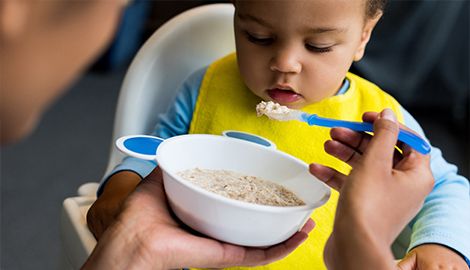The Basics: Feeding & Nutrition – 6 months to 2 years

Good nutrition is essential for child development. This is ever more important in the first two years of life, when children’s bodies and minds grow really quickly. Feeding children the liquids and foods appropriate for their age helps them grow healthy and strong.
Six Months to Two Years Old
When children are six months old, parents can begin introducing solid foods, but only if the children are meeting certain developmental milestones. For instance, they must have good head control, sit with little or no support, and open their mouths when food is offered. Talk to your child’s doctor or nurse to find out if they are ready to start eating solid foods. At six months, children can also begin drinking water (4-6 ounces per day) in addition to continuing to drink breast milk or formula. Children can begin drinking other beverages when they are 12 months old and, by 2 years of age, they should be able to eat the same foods as the rest of the family. See the CDC resources below for more information on the types of foods and drinks children should consume.
Transitioning to solid foods
It is important to introduce solid foods into a child’s diet slowly and safely. This means:
- Being mindful of choking hazards. Begin with small portions and with foods that do not require much, or any, chewing. Always watch your children when they eat.
- Identifying foods that can cause allergies. Introduce children to only one new food every 3 to 5 days to see if they have an allergic reaction to that food. Let your child’s doctor or nurse know if you, your child’s father, or anyone in your families have a food allergy before introducing this food to your child.
- Practicing proper food safety. Because children’s digestive and immune systems are not yet fully developed, they are at higher risk than adults for food poisoning or related illnesses. It is important for those preparing foods to wash their hands and surfaces often, cook foods at temperatures high enough to kill germs, separate cooked foods from raw foods (eggs, meat, poultry, and seafood), and refrigerate food quickly.
Avoid Over-feeding Through “Fullness” Cues
Children often give cues when they are full and do not want to eat any more. For instance, they might close their mouths, push food away, or turn their heads away from a spoon with food. Learning and listening to these cues can help parents promote healthy eating patterns in children from an early age. This can help reduce children’s likelihood of becoming overweight.
Helpful Resources
Foods and Drinks for 6- to 24-month-olds (CDC): This website provides detailed information about the amounts and types of foods to feed your child up to 2 years of age. It includes suggestions for dealing with “picky eaters” and resources for learning more about food preparation and safety. The information in this article is intended to be used for educational purposes only. It is not medical advice. Always consult a doctor or other healthcare professional when making decisions about your health.